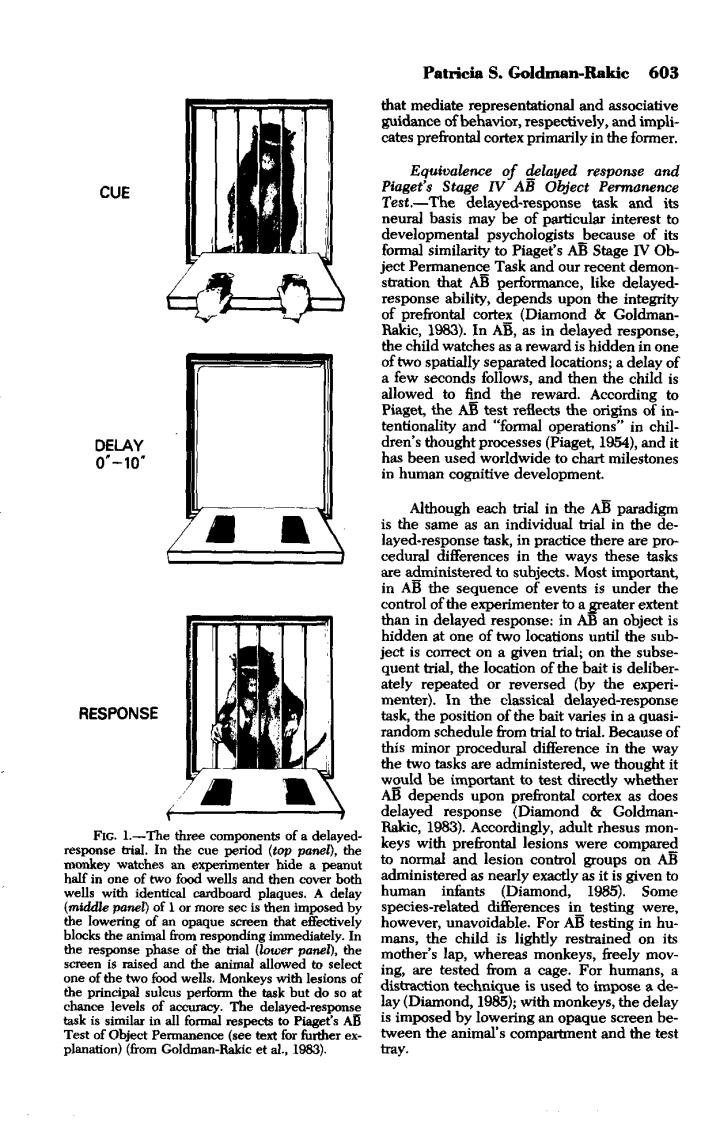正在加载图片...

Patricia S.Goldman-Rakic 603 that mediate cates prefrontal cortex primarily in the former response and CUE to iect Perman kic 1983). of two spatiallys rated locations:ade in one tolows,and then Piaget,the lity and 840 has been human cognitive development is the same as an ay these task inistered to subjects.Mo import the seque than in de nse:in Ap an ent trial th ate ocation of the In the expe RESPONSE task the of the bait varl in a quas is minor 0 n the the ks are a we tho AB de as Diamon keys with mo esion contro groups on human Diamond. es child on tec ed est the animal's cor ent and thePatricia S. Goldman-Rakic 603 CUE DELAY RESPONSE FIG. 1.—The three components of a delayedresponse trial. In the cue period (top panel), the monkey watches an experimenter hide a peanut half in one of two food wells and then cover bodi wells with identical cardboard plaques. A delay (middle panel) of 1 or more sec is Iben imposed by the lowering of an opaque screen that effectively blocks die animal from responding immediately. In the response phase of tiiie trial (lower panel), the screen is raised and the animal allowed to select one of the two food wells. Monkeys with lesions of the principal sulcus perform the task but do so at chance levels of accuracy. The delayed-response task is similar in all formal respects to Piaget's A 5 Test of Object Permanence (see text for furdier explanation) (from Goldman-Rakic et al., 1983). that mediate representational and associative guidance of behavior, respectively, and implicates prefrontal cortex primarily in the former. Equivalence of flayed response and Piaget's Stage IV AB Object Permanence Test.—The delayed-response task and its neural basis may be of particular interest to developmental psychologists _because of its formal similarity to Piaget's AB Stage IV Object Permanence Task and our recent demonstration that AB performance, like delayedresponse ability, depends upon the integrity of prefrontal cortejc (Diamond & GoldmanRakic, 1983). In AB, as in delayed response, the child watches as a reward is hidden in one of two spatially separated locations; a delay of a few seconds follows, and then the child is allowed to find the reward. According to Piaget, die AB test reflects the origins of intentionality and "formal operations" in children's diought processes (Piaget, 1954), and it has been used worldwide to chart milestones in human cognitive development. Aldiough each trial in the AB paradigm is the same as an individual trial in the delayed-response task, in practice there are procedural difiFerences in the ways these tasks are administered to subjects. Most important, in AB the sequence of events is under the control of the experimenter to a^reater extent than in delayed response: in AB an object is hidden at one of two locations until the subject is correct on a given trial; on the subsequent trial, the location of the bait is deliberately repeated or reversed (by the experimenter). In the classical delayed-response task, the position of the bait varies in a quasirandom schedule from trial to trial. Because of this minor procedural difference in the way the two tasks are administered, we thought it would be important to test directly whether AB depends upon prefrontal cortex as does delayed response (Diamond & GoldmanRakic, 1983). Accordingly, adult rhesus monkeys with prefrontal lesions were compared to nonnal and lesion control groups on AB administered as nearly exactly as it is given to human infents (Diamond, 1985). Some species-related differences in_ testing were, however, unavoidable. For AB testing in humans, the child is lighdy restrained on its mother's lap, whereas monkeys, freely moving, are tested from a cage. For humans, a distraction technique is used to impose a delay (Diamond, 1985); with monkeys, the delay is imposed by lowering an opaque screen between the animal's compartment and die test tray